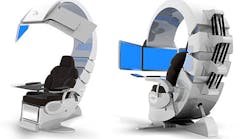A majority (74%) of senior high-tech supply chain professionals, surveyed by IDC Manufacturing Insights, expect high-tech exports to grow at the same or faster pace. In order to prepare for this the companies are reviewing a number of factors in building their supply chain networks.
A new study, UPS Change in the (Supply) Chain, found that while high-tech companies still favor the strategy of off-shoring as a means to cut labor costs, a large number also have begun “right-shoring.” This strategy optimizes the supply chain to take advantage of cost benefits and local resources to achieve the best customer service and overall profit margins.
“Customer requirements change rapidly, especially considering the steady stream of high-tech innovations and the fact that there is little to no downtime between product generations,” said Dave Roegge, high-tech marketing director at UPS.
Many of these companies see right-shoring as the solution. Right-shoring balances a number of factors to determine the proximity of sourced materials to production, warehousing and distribution. These metrics could include cost, quality and the time it takes to recover from any operational failures. Forty five percent of survey respondents said they use right-shoring strategies.
Off-shoring, which moves manufacturing or assembly to countries with low labor costs, remains the most common strategy. Forty seven percent of survey respondents said they off-shore. Near-shoring, which moves manufacturing or assembly closer to the location of demand, continues to gain in popularity as companies improve service levels, reduce inventory in transit and seek greater control over product quality and intellectual property. Thirty five percent of respondents said they near-shore. That’s a gain of 25 percentage points since 2010.
New opportunities emerge
Forty six percent of the respondents said they expect industry export growth globally to increase at the current pace over the next two years, while 28% of them expect faster growth. North American and Latin American respondents were the most optimistic about the future of high-tech exports.
High-tech companies have successfully penetrated many emerging markets. Among survey respondents, 71% said they are already selling products in China, 45% in India and 42% in Brazil. Some high-tech markets once considered “emerging” have now emerged, but growth opportunities remain. The top three markets that high-tech companies are planning to enter this year are Brazil, Russia and India.
Although new-market penetration is high, barriers to expansion continue to evolve. In 2013, the top barrier to expanding in emerging markets was difficulty assessing the likely appeal of products. In the most recent survey, 35% of survey respondents said navigating the regulatory environment was the new highest hurdle to expansion.
3-D printing useful in product design
The survey also explores the commercial adoption of 3-D printing. Seventy percent of survey respondents report having hands-on experience with it, including 32% who said they are just beginning to understand it.
For now, high-tech companies use 3-D printing mainly to spur innovation as they design new products. The top benefits include faster product development and manufacturing processes. Regionally, 43% of respondents in the Asia Pacific region – primarily high-tech manufacturers in China – said they use 3-D printing for production of finished goods. In North America, 29% of respondents said they use 3-D printing for this purpose.



